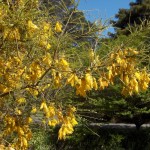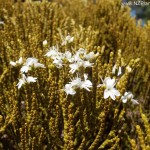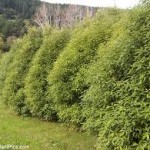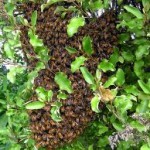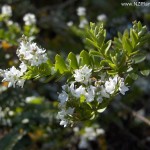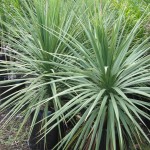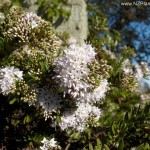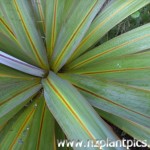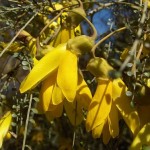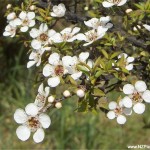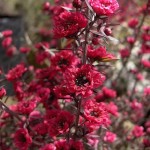NZ Native “Kiwi gems” – some hints about care, selection and planting for your garden
By Wally Richards
New Zealand has a vast array of native plants which many New Zealand gardeners sometimes take for granted, as they are very common in their homeland.
Overseas, many of our indigenous plants are well sort after and considered prized processions.
I remember several years ago Kew Gardens contacting me to assist in obtaining a number of natives in ‘fresh seed’ form. I was able to purchase some for their requirements from local seed collectors and send them over to England for a special New Zealand Native Garden Kew was developing.
I still have a photocopy of the Kew Garden’s cheque, as it was such a highlight for me.
Through the Internet back in the 90’s several gardeners in America also contacted me for seeds of various native plants that they wanted for their collections. This stopped when seed importation into the US had to be put through expensive checks for bio security reasons.
Natives can be planted at any time with due care to their establishment, but the very best time to plant is in the autumn, as they require very little assistance to establish.
Native shrubs and trees have adapted to New Zealand conditions over thousands of years making them very suitable to grow in your gardens. The chances of failure is low as long as you don’t try to make one grow in conditions that it is not accustomed to. (Soil type and moisture aspects)
The more readily available natives from garden centres have labels outlining the best site and care. Some cannot handle wet feet for extended periods but most will grow in heavy soils as long as the drainage is reasonable.
Once established they need only an annual trim to keep them in shape and prevent their hogging the sunlight from their neighbouring plants. A few pests can attack them but as they are used to native pests they will survive without any intervention from you. (Mind you its nice to remove the pests and keep the foliage clean…)
Most natives are very suitable container plants as long as you give them a good size pot to grow in. A mix of mostly compost and a little top soil is a good mix for them and if you can, put a few worms into the mix to keep it open and aerated in the pot.
Cabbage Trees – Cordyline
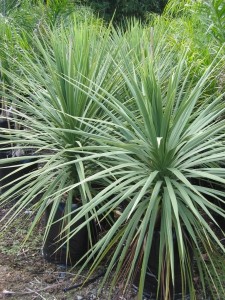
Cordyline australis (image Bakerboys Wholesale Nursery)
Cabbage trees are good container specimens for large containers. Juvenile foliage makes an impressive display as the plant grows towards to sky. Later as it matures the older leaves can be discarded showing the trunk. (More impressive in my mind than Yuccas which are currently popular container plants.) Take the rich colour of Cordyline australis purpurea (the purple Cabbage tree) with its bronze like purple leaf colouring and you have a majestic plant for both garden and tub.
They take from very wet to dry situations with ease, don’t mind a bit of shade or care about soil type. The only pest problem they have is with the cabbage tree moth, whose caterpillars eat the foliage in summer.
Sprinkle Neem Tree Granules around the base of the plant in spring and again in summer for reasonable control. In fact most natives that have any insect problem can be solved with Neem Tree Granules and an occasional spray of Neem Tree Oil.
There are other Cordylines that you can grow also for their unique foliage such as Cordyline Stricta with its narrow sword like leaves.
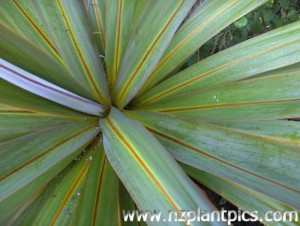
Cordyline indivisa
Pittosporum

Pittosporum
A very popular native family is the Pittosporum of which there is such a diverse range of foliage types and colours. They do not tolerate wet feet for extended periods but are fine in drier areas. In one place I lived I had a very wet heavy clay section and found that my first plantings of Pittosporum failed until other natives were established and then they never looked back. They seed well and you can collect as many seedlings as you like later on. If you have a few different types near each other you will get cross pollination and the seedlings can be very different from the parents.
Growing from seed will generate much better plants than from cuttings but both propagation techniques are straight forward. It is easy to collect the ripe seed and sow them where you want the plants to grow. Ideal for wind breaks, screens, individual specimens as well as container plants. Spray the foliage with Neem Tree Oil about every 2-4 weeks from November through to March to keep the pest insect (Psyllids) under control. Psyllids cause the bubbles and distortions in the leaves.

Pittosporum
Hebe

Hebe wiri mist (image NZ Plant Pics)
Another big family of natives is the Hebe with a big range of foliage types and flower colours. Hardy, as they are suitable for any location that is not too shady. Several years ago a gardener in Palmerston North gave me a cutting of Hebe ‘sport’ that had appeared in their garden a few years before. It had foliage that changed colour with the seasons and lovely pink flowers. I had the plant registered as Hebe ‘Pink Goddess’ and is available still, to the best of my knowledge.
There are Hebe that have a slightly sprawling growth pattern and if you take one of these and plant it into a good size container. Next lightly trim the tips off all the branches and allow all the new shoots to grow. When they have reached a good size, tip them again. This can be done as many times as needed to get a thick display of foliage that sprawls over the sides of the container and reaches sky ward in the centre.
When the plant flowers, later on, you will have a great display as it should be just covered in blossom. I have not found any problems with any Hebe unless they become too crowded from other plants and then they become misshapen seeking the sun.
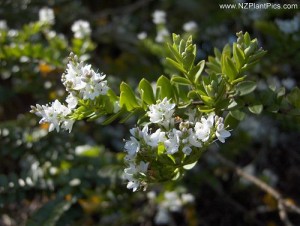
Hebe vernicosa
Pseudopanax

Pseudopanax arboreus (image NZ Plant Pics)
Pseudopanax are another very hardy plant for any situation. Fast growing with larger leaves than many other natives and they don t mind a shady spot. Tolerant of wet areas and the new forms have a great range of foliage colours including near black and yellow.
The coloured ones must have plenty of sun or they will lose their colours.
I used to love visiting a local nursery (P.Nth) called Midlands, when I had a garden centre and pick out Pseudopanax for resale from the great selection they have. Sometimes the coloured or variegated ones start to revert to green and when this starts to happen the green should be cut out. They are ideal for containers too.
Pseudopanax also can be affected by Psyllids marking the foliage, so spray with Neem Tree Oil when that happens. If I had more room, I would have a good collection of these natives.
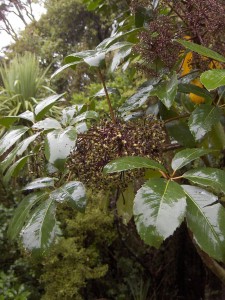
Pseudopanax arboreus (image NZ Plant Pics)
Manuka – Leptispermum
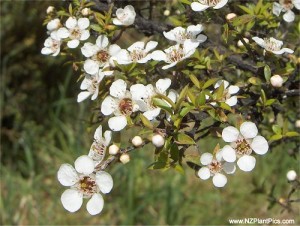
Manuka – tea tree
Manuka or Leptospermum is another range of natives that now have a good selection of flower colours. They are hardy plants but are often attacked by scale insects that cause the black sooty mould. Neem Tree Oil will also keep the pest at bay. A few Manuka planted will thrill you when they flower.
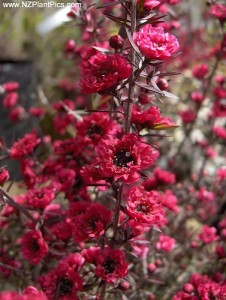
Leptospermum scoparium ‘Burgundy queen’ (image NZ Plant Pics)
Kowhai – Sophora
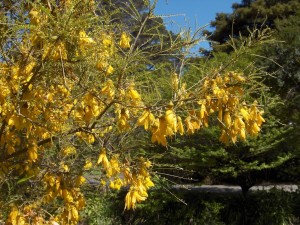
Sophora microphylla kowhai (image NZ Plant Pics)
No garden is complete without a Kowhai or two to grace an area or container. I have one that I made into bonsai many years ago and at only just over a 40cm tall it flowers every year making a neat display.
The natives above are some of the most popular and you will find a good selection of them in your local garden centre and from the nurseries on findaplant.co.nz
- Sophora microphylla kowhai (image NZ Plant Pics)
- Hebe wiri mist (image NZ Plant Pics)
- Pittosporum
- Pittosporum
- Pseudopanax arboreus (image NZ Plant Pics)
- Hebe vernicosa
- Pseudopanax arboreus (image NZ Plant Pics)
- Cordyline indivisa
- Manuka – tea tree
- Leptospermum scoparium ‘Burgundy queen’

